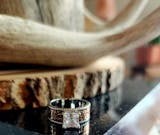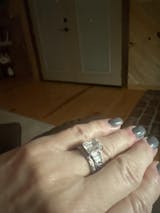The band width of your engagement ring shapes its entire appearance and feel. A thin 1mm band can make your center stone look larger, while a wider 4.5mm band creates a bolder look. The right width for you depends on your finger size, what you do every day, and the style you like best. The band width affects both how comfortable your ring feels and how it looks with your chosen stones and setting.
Common Band Width Options
The band width refers to the measurement across your ring's band, from one edge to the other. Jewelers measure this distance in millimeters (mm), giving you precise measurements to compare different styles. Think of it like measuring the width of a ribbon - the measurement tells you exactly how much space the ring will take up on your finger.
Thin Bands: 1-2 mm
Thin bands offer a subtle, refined look. At 1 mm, the band appears very delicate, while a 2 mm width provides slightly more stability while maintaining a graceful profile. These bands work well with prominent center stones.
Medium Bands: 2.5-4 mm
Medium-width bands strike a balance between delicate and substantial. A 3 mm band represents the most popular choice for engagement rings, offering enough metal to secure stones while maintaining an elegant appearance.

Wide Bands: 4.5 mm and Above
Wide bands make a strong visual statement. Starting at 4.5 mm, these bands offer extra durability and space for detailed designs or multiple stone settings. Some statement pieces can reach 6 mm or more, though these larger widths may feel heavy on smaller hands.
Each width category serves different practical and aesthetic purposes. The size you choose affects not just how the ring looks, but also how securely it holds stones and how it feels during daily wear.

Factors Influencing Band Width Choice
Your personal style, the shape of your hand and fingers, and your lifestyle are all important things to think about when choosing the right band width for your engagement ring.
1. Personal Style Preferences
The engagement ring you choose should match your personal taste and style. If you like understated, minimalist designs, a thin band could be a good fit. If you prefer bolder, more noticeable styles, a wider band might be better for you.
Consider whether you gravitate towards classic, traditional designs or more modern, contemporary looks. This can help guide you in picking a band width that fits your overall style.
2. Hand and Finger Shape Considerations
The size of your hand and the shape of your fingers can also affect which band width looks best. For smaller hands or slim fingers, a thin or medium band usually creates a more balanced, proportional look. A very wide band might overwhelm small fingers and feel less comfortable.
If you have larger hands or wider fingers, a medium or wide band often creates a better visual balance. A very thin band could look too small or get lost on a larger hand.
3. Lifestyle and Practicality
It's also important to think about your daily activities and lifestyle when deciding on a band width. If you're very active or work a lot with your hands, a wider band is often more durable and practical. Thin bands are usually more delicate and can bend or get damaged more easily.
Comfort matters a lot, too, since you'll be wearing your engagement ring all the time. Some people find very thin or very wide bands less comfortable for everyday wear. A medium band is frequently a good balance of style and comfort.
When you're picking your ideal engagement ring band width, take your personal style, your hand and finger proportions, and your lifestyle into account. Finding the right mix of these factors will help you choose a ring that feels like a natural fit for your taste and way of life.
Pros and Cons of Different Band Widths
Each band width comes with its own set of advantages and drawbacks. To help you weigh your options, here's a breakdown of the main pros and cons for thin, medium, and wide bands:

Thin Bands
Pros:
- Thin bands offer a sleek, elegant aesthetic that many people find appealing.
- With a thin band, the center stone often appears larger and more prominent.
- Another advantage of thin bands is that they are usually lightweight and comfortable to wear for extended periods.
Cons:
- One potential drawback of thin bands is that they are often less durable and more prone to bending or warping over time.
- Additionally, thin bands may twist or spin on your finger more easily than thicker bands.
Medium Bands
Pros:
- Medium bands provide a balanced, proportional look that complements a wide range of ring styles.
- Their versatility allows them to accommodate a variety of center stone sizes without overpowering or understating the stone.
- For many people, medium bands offer a comfortable width for daily wear.
Cons:
- While medium bands are a classic choice, they may not make as bold of a statement as a wide band if you're seeking a ring that really stands out.
Wide Bands
Pros:
- Wide bands make a bold, substantial statement on the finger.
- In terms of durability, wide bands are often more resistant to everyday wear and tear.
- Even without a large center stone, a wide band can create a strong visual impact.
Cons:
- Due to their size, wide bands are often heavier than thin or medium bands, which some people may find less comfortable for extended wear.
- When paired with a smaller center stone, a very wide band can sometimes overshadow or dwarf the stone.
As you consider which band width is right for you, take these pros and cons into account. Ultimately, the best choice will depend on your individual priorities and preferences.
How to Match Band Width with Ring Design
The band width you choose can significantly impact the overall look of your engagement ring, depending on the setting and style. Here's how band width can affect different ring designs:
Pairing with Solitaire Settings
When it comes to solitaire settings, the band width can greatly influence how the center diamond is showcased. A thin band can make the diamond appear larger and more prominent, drawing the eye to the stone. On the other hand, a wide band can provide a sturdy base for the solitaire, creating a bold and substantial look. Consider the size of your diamond and the effect you want to achieve when choosing between a thin or wide band for a solitaire setting.
Multi-Stone and Halo Settings
For rings with more intricate designs, such as those with multiple stones or halo settings, the band width plays a role in balancing the overall appearance. A wider band can enhance the presence of a multi-stone or halo setting, providing a proportionate foundation for the intricate design. However, if you prefer a more delicate look, a thinner band can allow the details of the setting to take center stage. Pay attention to the symmetry of the ring and choose a band width that complements the overall design.
Mixed Metal and Textured Bands
If you're considering a mixed metal or textured band, the width can be used to create contrast and visual interest. A wider band allows more space for incorporating different metal colors or textures, such as braided, hammered, or brushed finishes. These design elements can add depth and dimension to the ring. On the other hand, a thinner mixed metal or textured band can provide a subtle touch of unique style without overpowering the center stone.
When selecting your band width, think about how it will interact with the specific design elements of your chosen ring setting. The right combination of band width and ring style will create a cohesive and beautiful piece that reflects your personal taste.
Find Your Ideal Engagement Ring Band Width!
Choosing the right engagement ring band width depends on your personal style, hand shape, and daily activities. The options range from thin (1-2 mm) to wide (4.5 mm and above), each offering unique advantages. Consider how the band width will look with your chosen ring setting, complement your hand, and feel during everyday wear. The perfect band width should not only look beautiful but also feel comfortable and reflect your individual personality. By carefully weighing these factors, you'll find a ring that truly feels like it was made just for you.











